Study on the Mechanical Properties of MiC Formworks with Different Material Components
Abstract
:1. Introduction
2. Materials and Methods
2.1. Materials
2.1.1. Concrete
2.1.2. Steel Bars
2.2. Specimen Design
- (1)
- The first specimen was used as a benchmark, namely, N60. Its concrete floor was made of C60 concrete.
- (2)
- The second specimen with C40 concrete floor was marked as N40.
- (3)
- The third specimen was marked as SF60. Its concrete floor was made of C60 steel fiber concrete.
2.3. Loading Device and Scheme
2.4. Measuring Point Arrangement
3. Test Results and Analysis
3.1. Test Phenomenon
3.2. Load–Strain Curve
3.3. Load–Deflection Curve
3.4. Bearing Capacity Analysis
4. Numerical Simulation
4.1. Constitutive Relationship of Materials
4.2. Model Establishment
4.3. Analysis of the Finite Element Results
4.3.1. Deflection Analysis
4.3.2. Plastic Damage of Concrete
5. Parametric Analysis
6. Conclusions
- (1)
- The crack development, distribution pattern, and deformation of the three specimens were similar. The cracks appeared in the stressed area first, then gradually developed and extended through the whole plate surface with the increase in the load. The front cracks were mainly concentrated under each joist bar, while the back cracks were symmetrically distributed at the centerline of adjacent joist bars. The width of cracks in each specimen was different due to different concrete strengths and steel fiber mixing.
- (2)
- The damage patterns of the three specimens were different. The specimen without steel fibers was damaged due to a lack of ultimate bearing capacity, while the specimen with steel fibers was damaged due to reaching the upper limit of code deflection. Therefore, increasing the strength of concrete can significantly increase the bearing capacity of the specimens. In contrast, the incorporation of steel fibers significantly increased the crack resistance and stiffness of the specimens but not the bearing capacity.
- (3)
- The results of the numerical analysis were close to the test results, and the stress distribution pattern was similar. The distribution pattern of the tensile and compressive damage on the surface of each specimen was approximately the same. The tensile damage was higher than the compressive damage in the damage degree. Combined with the parametric analysis, it is clear that increasing the steel fiber dosage has limited improvement on the cracking resistance of the specimens as the strength class of the concrete matrix increases.
Author Contributions
Funding
Data Availability Statement
Conflicts of Interest
References
- Murray-parkes, J.; Bai, Y.; Styles, A.; Wang, A. Handbook for the Design of Modular Structures, Modular Construction Codes Board; Monash University: Melbourne, Australian, 2017; pp. 1–216. [Google Scholar]
- Gunawardena, T.; Ngo, T.; Mendis, P.; Alfano, J. Innovative flexible structural system using prefabricated modules. J. Archit. Eng. 2016, 22, 05016003. [Google Scholar] [CrossRef]
- Sharafi, P.; Mortazavi, M.; Samali, B.; Ronagh, H. Interlocking system for enhancing the integrity of multi-storey modular buildings. Autom. Constr. 2018, 85, 263–272. [Google Scholar] [CrossRef]
- Samali, B.; Nemati, S.; Sharafi, P.; Abtahi, M.; Aliabadizadeh, Y. An experimental study on the lateral pressure in foam-filled wall panels with pneumatic formwork. Case Stud. Constr. Mater. 2018, 9, e00203. [Google Scholar] [CrossRef]
- Wang, Z.; Pan, W.; Zhang, Y. Parametric study on module wall-core system of concrete modular high-rises considering the influence of vertical inter-module connections. Eng. Struct. 2021, 241, 112436. [Google Scholar] [CrossRef]
- Yin, S.P.; Xu, S.L.; Wang, F. Investigation on the flexural behavior of concrete members reinforced with epoxy resin-impregnated textiles. Mater. Struct. 2015, 48, 153–166. [Google Scholar] [CrossRef]
- Li, S.; Yin, S.; Wang, C.; Yang, Y. Research on the bonding performance of TRC permanent formwork and cast-in-place concrete. Eng. Struct. 2021, 235, 112021. [Google Scholar] [CrossRef]
- Yang, Y.; Chen, B.; Chen, Y.; Zhou, H.; Liu, F.; Xie, X.; Chen, J.; Guo, W.; Wang, H. Performances of Concrete Columns with Modular UHPC Permanent Formworks Under Axial Load. Int. J. Concr. Struct. Mater. 2023, 17, 38. [Google Scholar] [CrossRef]
- Li, S.; Yin, S. The influence of the bonding length on the failure mechanism of the interface between the TRC permanent formwork and cast-in-place concrete. Structures 2021, 29, 1690–1698. [Google Scholar] [CrossRef]
- Zhu, B.; Nematollahi, B.; Pan, J.; Zhang, Y.; Zhou, Z.; Zhang, Y. 3D concrete printing of permanent formwork for concrete column construction. Cem. Concr. Compos. 2021, 121, 104039. [Google Scholar] [CrossRef]
- Wang, L.; Yang, Y.; Yao, L.; Ma, G. Interfacial bonding properties of 3D printed permanent formwork with the post-casted concrete. Cem. Concr. Compos. 2022, 128, 104457. [Google Scholar] [CrossRef]
- Wang, L.; Yang, Y.; Hu, Y.; Ma, G. Interfacial Properties of Three-Dimensional-Printed Permanent Formwork with Cast-in-Place Concrete. 3D Print. Addit. Manuf. 2022. [Google Scholar] [CrossRef]
- Chen, Y.; Zhang, Y.; Liu, Z.; Zhang, Y.; Liu, C.; Pang, B. 3D-printed concrete permanent formwork: Effect of postcast concrete proportion on interface bonding. Mater. Lett. 2023, 344, 134472. [Google Scholar] [CrossRef]
- Zhang, R.; Hu, P.; Zheng, X.; Cai, L.; Guo, R.; Wei, D. Shear behavior of RC slender beams without stirrups by using precast U-shaped ECC permanent formwork. Constr. Build. Mater. 2020, 260, 120430. [Google Scholar] [CrossRef]
- Li, H.; Leung, C.K.Y.; Xu, S.; Cao, Q. Potential use of strain hardening ECC in permanent formwork with small scale flexural beams. J. Wuhan Univ. Technol. -Mater. Sci. Ed. 2009, 24, 482–487. [Google Scholar] [CrossRef]
- Li, Q.H.; Huang, B.T.; Xu, S.L. Development of assembled permanent formwork using ultra high toughness cementitious composites. Adv. Struct. Eng. 2016, 19, 1142–1152. [Google Scholar] [CrossRef]
- Huang, B.T.; Li, Q.H.; Xu, S.L.; Li, C.F. Development of reinforced ultra-high toughness cementitious composite permanent formwork: Experimental study and digital image correlation analysis. Compos. Struct. 2017, 180, 892–903. [Google Scholar] [CrossRef]
- Li, S.; Yin, S. Research on the mechanical properties of assembled TRC permanent formwork composite columns. Eng. Struct. 2021, 247, 113105. [Google Scholar] [CrossRef]
- Daskiran, M.M.; Daskiran, E.G.; Gencoglu, M. Seismic performance of PVA textile cementitious composites used as permanent formwork in full-scale circular RC columns. Structures 2022, 36, 445–462. [Google Scholar] [CrossRef]
- Yin, S.; Cong, X.; Wang, C.; Wang, C. Research on flexural performance of composited RC beams with different forms of TRC permanent formwork. Structures 2021, 29, 1424–1434. [Google Scholar] [CrossRef]
- Zhang, H.; Rasmussen, K.J.; Ellingwood, B.R. Reliability assessment of steel scaffold shoring structures for concrete formwork. Eng. Struct. 2012, 36, 81–89. [Google Scholar] [CrossRef]
- Cardellicchio, L. On conservation issues of contemporary architecture: The technical design development and the ageing process of the Jubilee Church in Rome by Richard Meier. Front. Archit. Res. 2018, 7, 107–121. [Google Scholar] [CrossRef]
- Echenagucia, T.M.; Pigram, D.; Liew, A.; Van Mele, T.; Block, P. A cable-net and fabric formwork system for the construction of concrete shells: Design, fabrication and construction of a full scale prototype. Structures 2019, 18, 72–82. [Google Scholar] [CrossRef]
- Guo, X.; Qian, S.-S.; Qing, Q.; Gong, J.-H. Reinforcement by polyurethane to stiffness of air-supported fabric formwork for concrete shell construction. J. Cent. S. Univ. 2019, 26, 2569–2577. [Google Scholar] [CrossRef]
- Gong, C.; Kang, L.; Liu, L.; Lei, M.; Ding, W.; Yang, Z. A novel prediction model of packing density for single and hybrid steel fiber-aggregate mixtures. Powder Technol. 2023, 418, 118295. [Google Scholar] [CrossRef]
- Cao, Q.; Zheng, H.; Ju, H.; Lin, Z.; Zhou, C.; Jia, J. Early-Age Cracking Resistance of Multiscale Fiber-Reinforced Concrete with Steel Fiber, Sisal Fiber, and Nanofibrillated Cellulose. J. Mater. Civ. Eng. 2023, 35, 04023065. [Google Scholar] [CrossRef]
- Jiang, W.; Zheng, X.; Huang, Z. Lateral pressure of poured concrete: Arguments from ultra-deep diaphragm wall (120 m) construction. Appl. Sci. 2022, 12, 8800. [Google Scholar] [CrossRef]
- Genikomsou, A.S.; Polak, M.A. Finite element analysis of punching shear of concrete slabs using damaged plasticity model in ABAQUS. Eng. Struct. 2015, 98, 38–48. [Google Scholar] [CrossRef]
- Lihua, X.; Changning, L.; Biao, L.; Yin, C.; Biao, H. Investigation on 1D elasto-plastic constitutive model of steel fiber reinforced concrete under uniaxial cyclic compression. China Civ. Eng. J. 2018, 51, 77–87. [Google Scholar]
- Yin, C.; Le, H.; Min, Y. Calibration Method of Damage Plasticity Model for Steel-Polypropylene Hybrid Fiber Reinforced Concrete Based on ABAQUS. Eng. Mech. 2017, 34, 131–142. [Google Scholar]


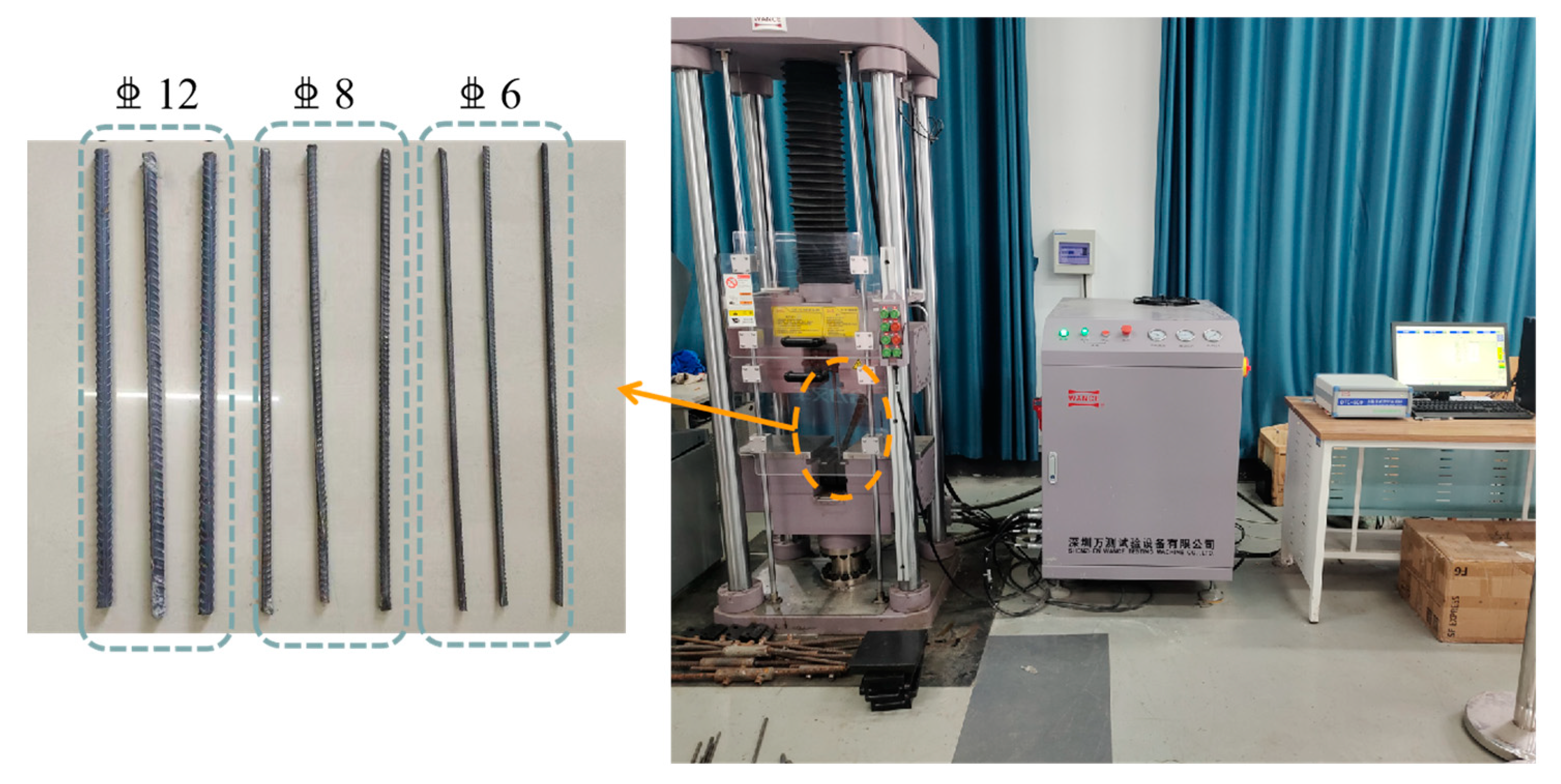

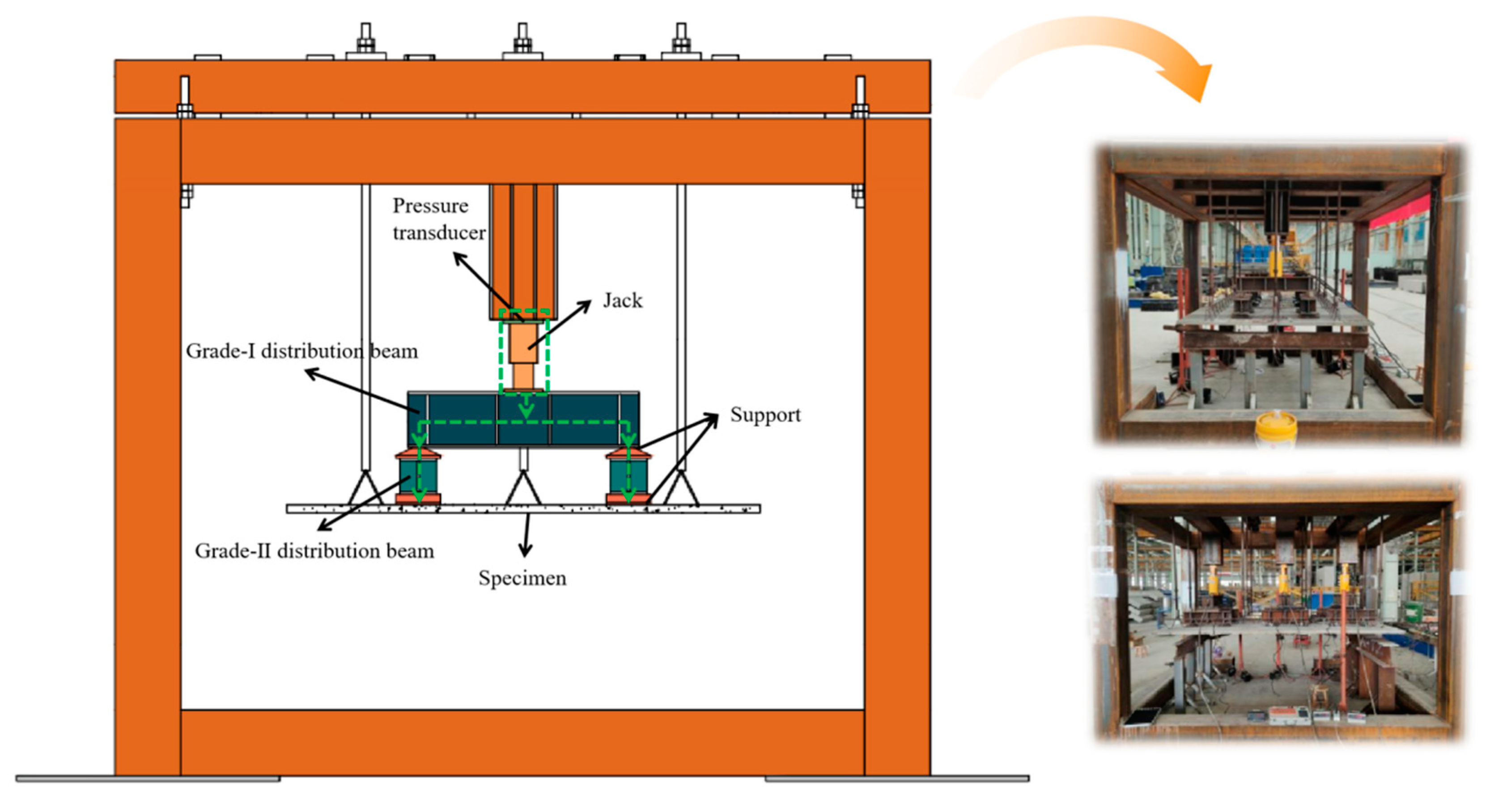
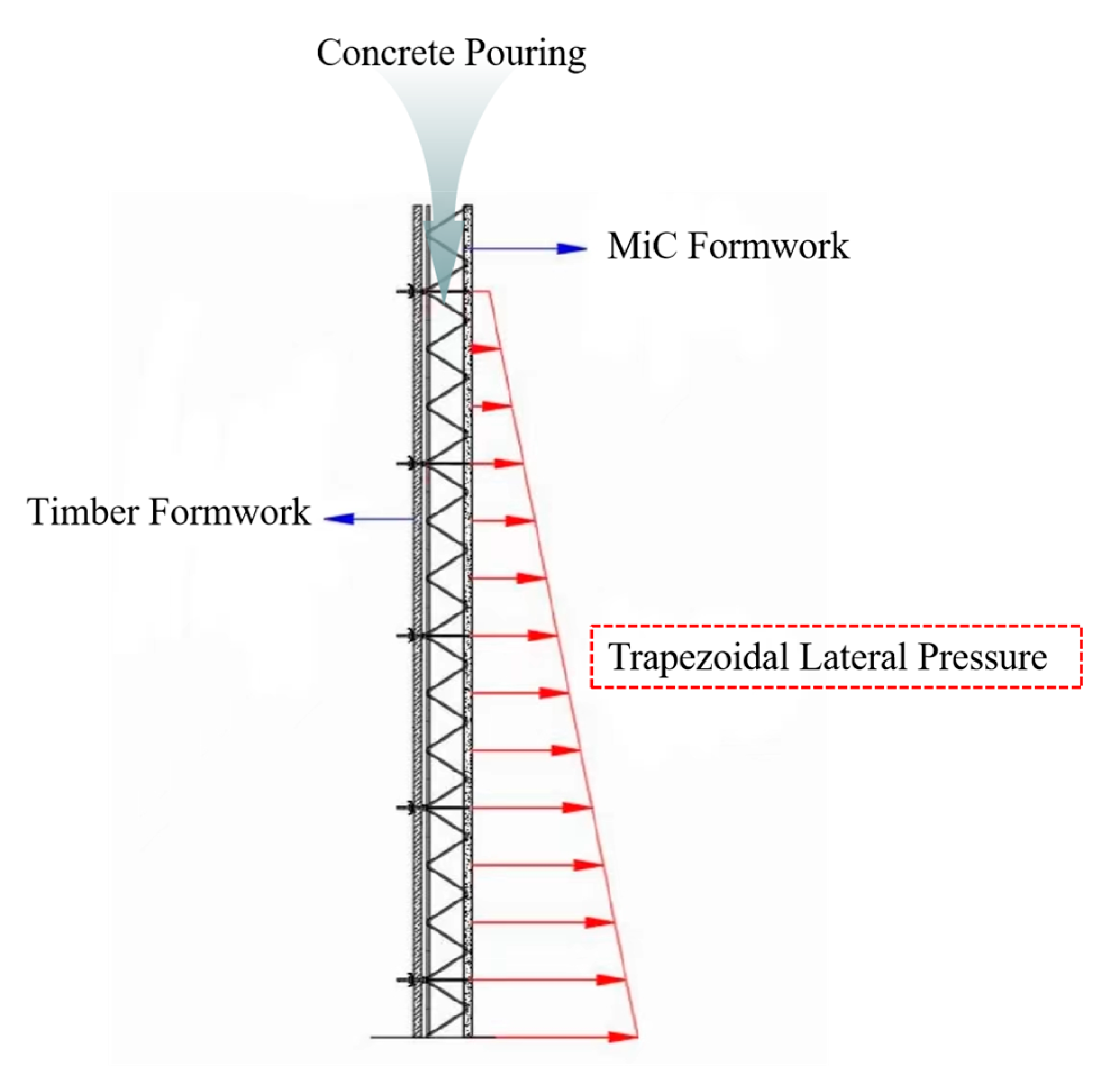

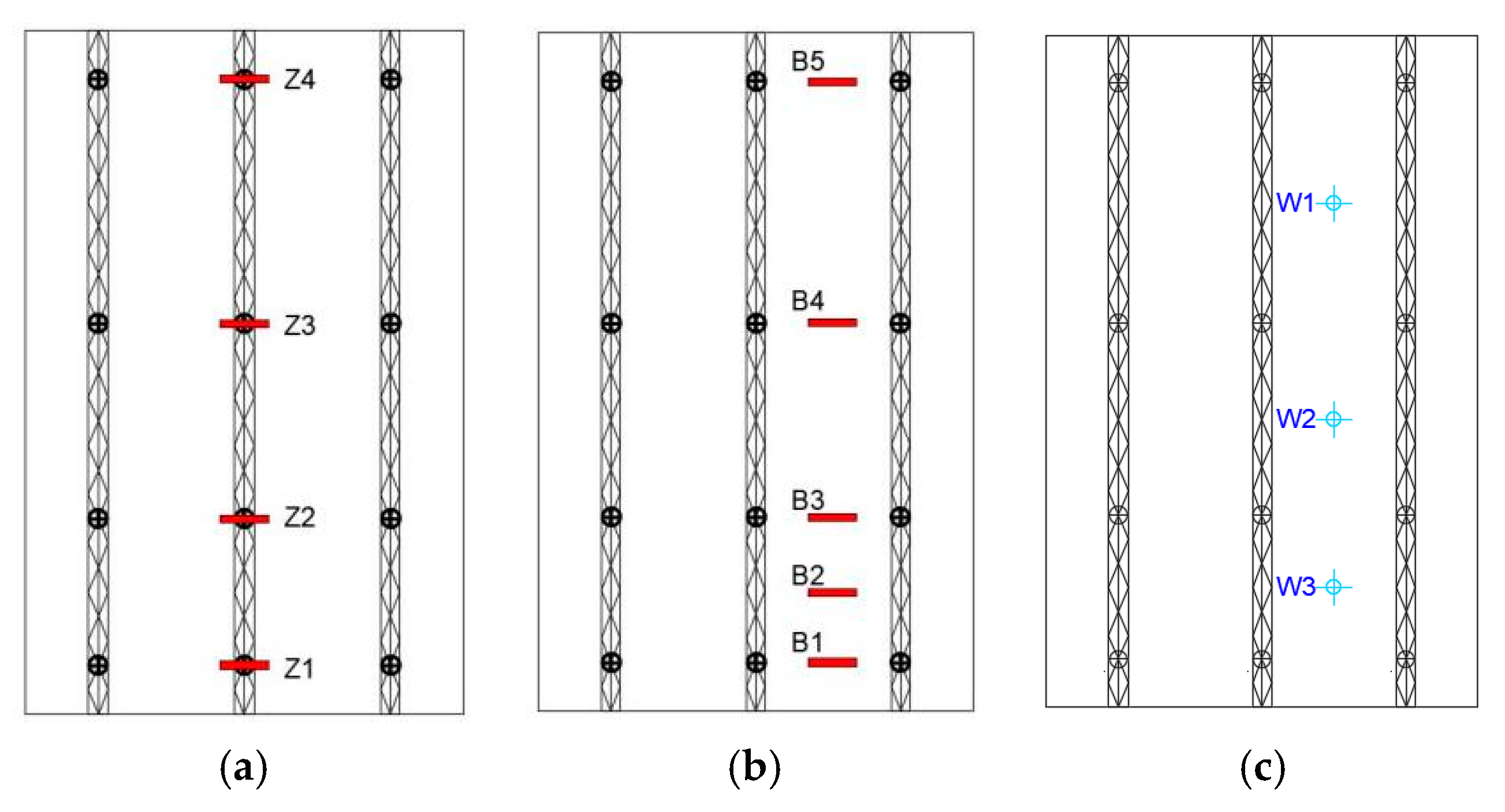







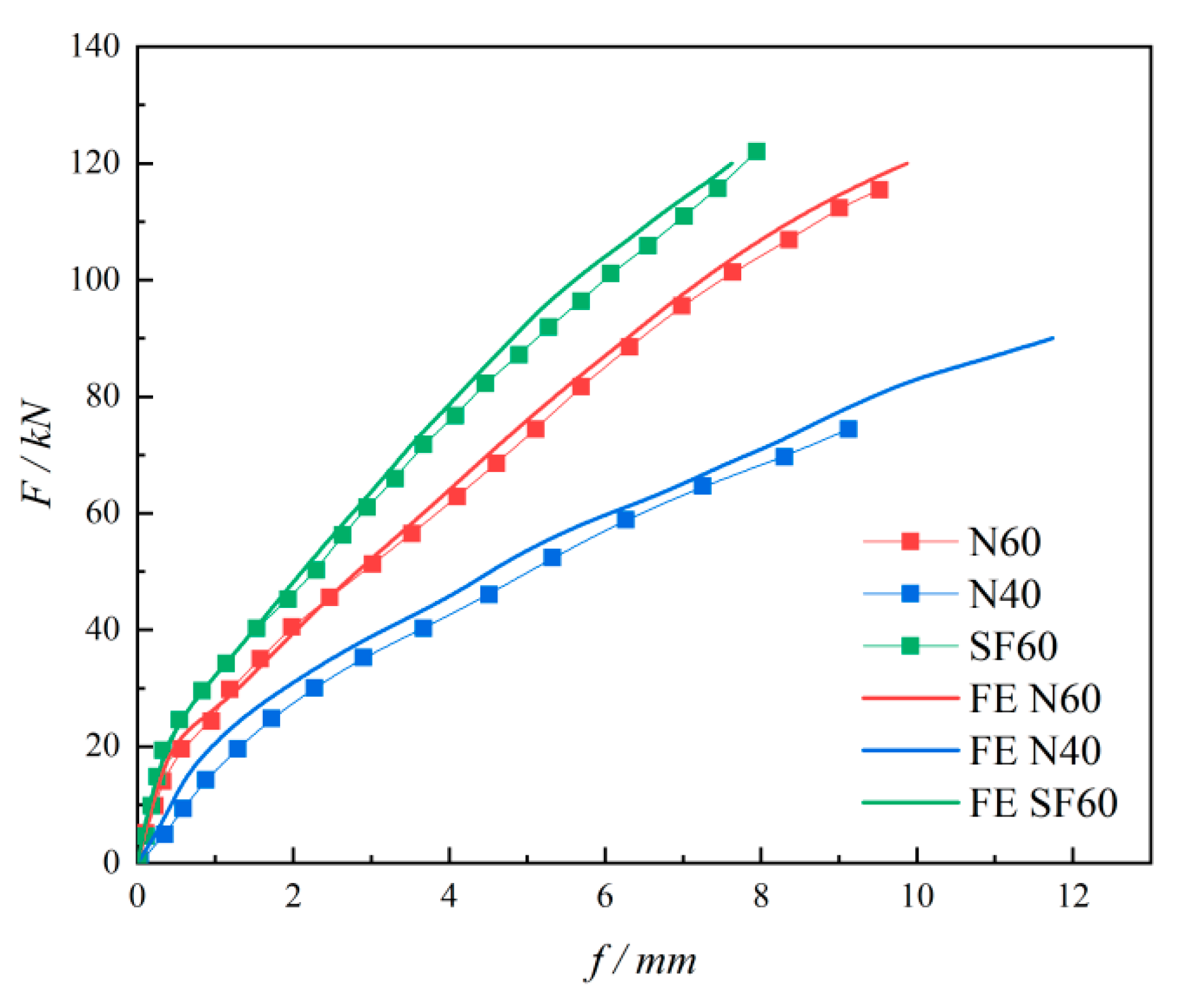
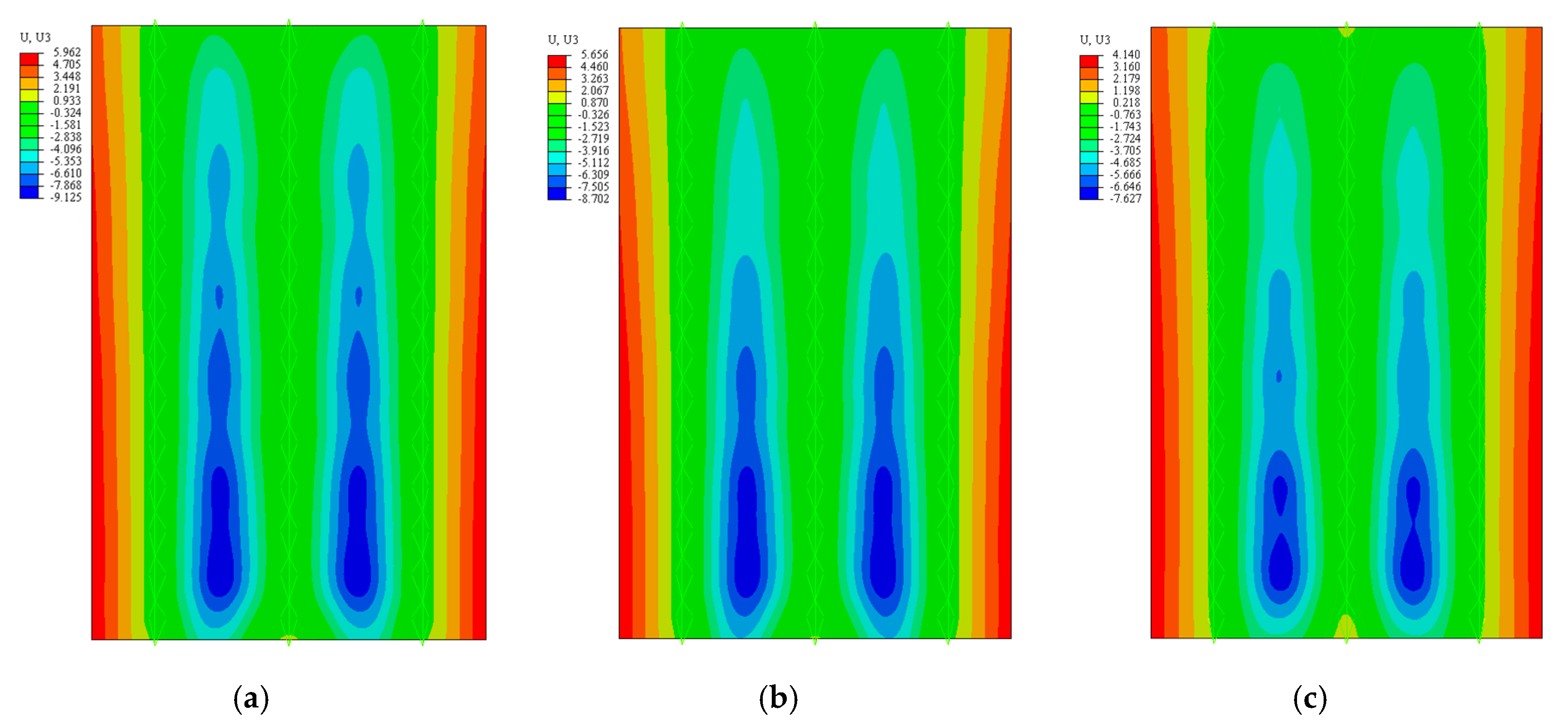
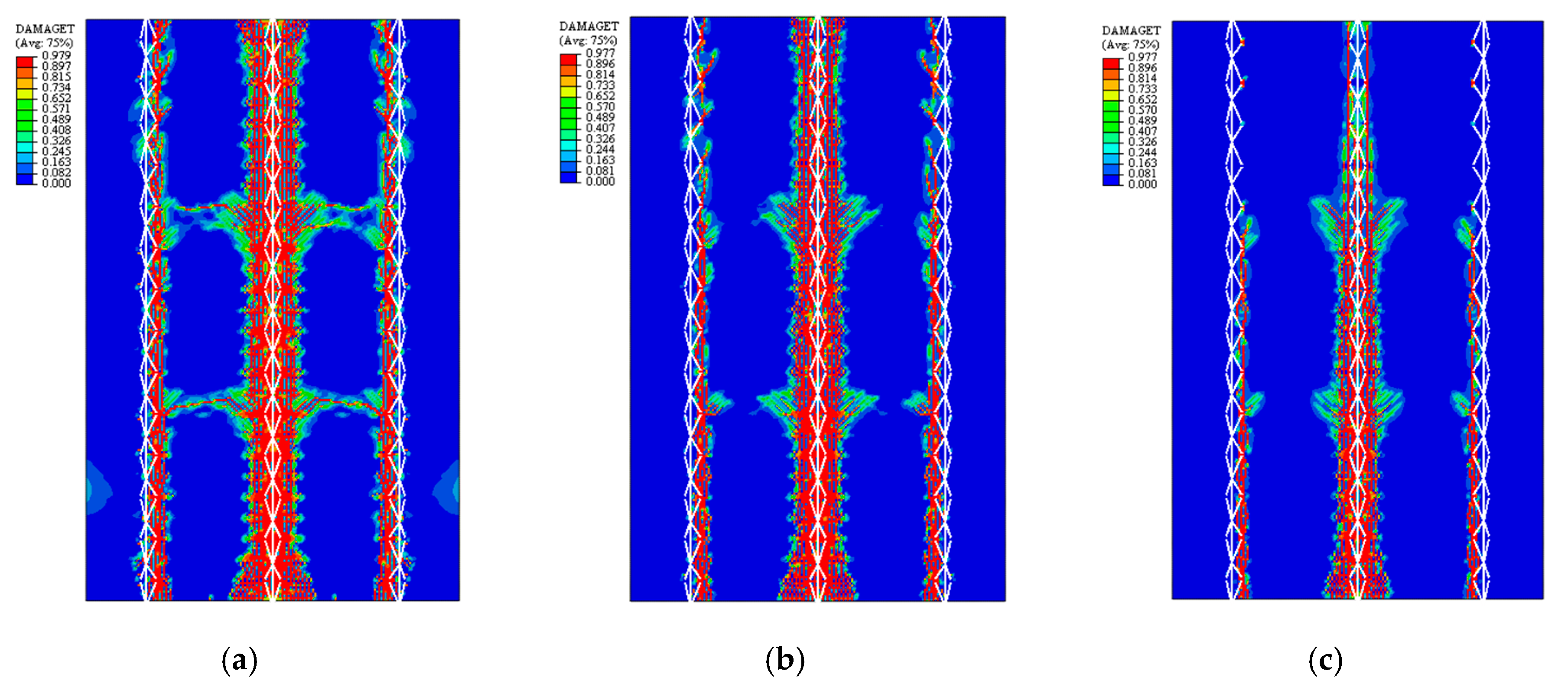


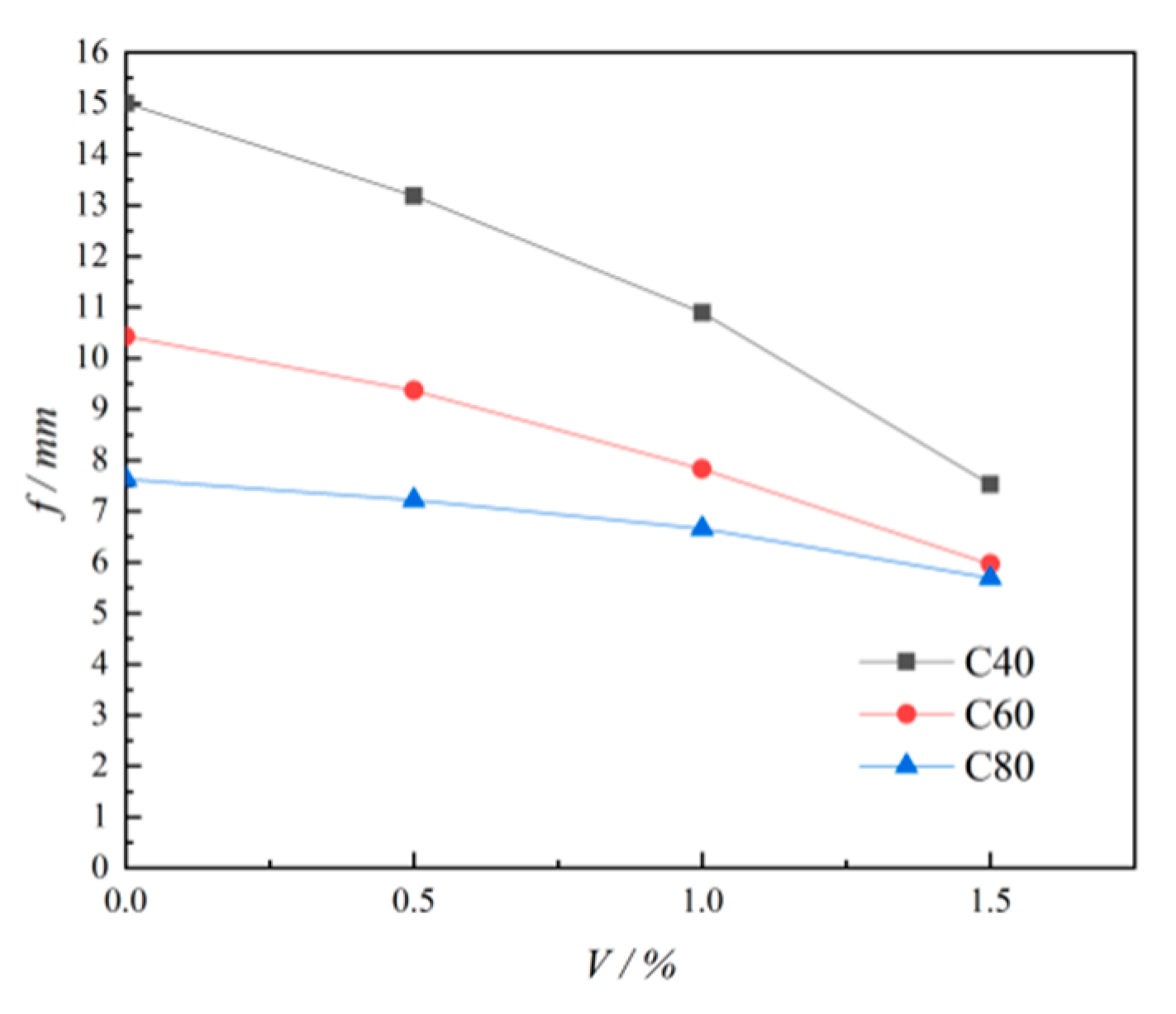
| Concrete Materials | Numbering | Measured Compressive Strength (MPa) | Conversion Compressive Strength (MPa) | Average (MPa) |
|---|---|---|---|---|
| C40 concrete | C40-1 | 43.5 | 41.33 | 41.42 |
| C40-2 | 42.7 | 40.57 | ||
| C40-3 | 44.6 | 42.37 | ||
| C60 concrete | C60-1 | 64.4 | 61.18 | 60.99 |
| C60-2 | 63.5 | 60.33 | ||
| C60-3 | 64.7 | 61.46 | ||
| C60 steel fiber-reinforced concrete | SFC60-1 | 64.9 | 61.65 | 62.35 |
| SFC60-2 | 66.7 | 63.36 | ||
| SFC60-3 | 65.3 | 62.03 |
| Reinforcement Diameter (mm) | Numbering | Yield Strength (MPa) | Average (MPa) | Ultimate Tensile Strength (MPa) | Average (MPa) |
|---|---|---|---|---|---|
| 6 | D6-1 | 438.3 | 443.4 | 589.2 | 589.2 |
| D6-2 | 451.5 | 571.6 | |||
| D6-3 | 440.6 | 576.9 | |||
| 8 | D8-1 | 438.1 | 436.1 | 566.8 | 576.4 |
| D8-2 | 421.7 | 578.2 | |||
| D8-3 | 448.6 | 584.3 | |||
| 12 | D12-1 | 431.9 | 427.2 | 566.8 | 566.8 |
| D12-2 | 420.6 | 572.3 | |||
| D12-3 | 428.5 | 559.4 |
| ID | Mesh Size (L × B × H) | Grade of Concrete | Additional Material | Grade of Steel Bars | ID |
|---|---|---|---|---|---|
| N60 | 2.8 m × 1.8 m × 0.03 m | C60 | - | HRB400 | N60 |
| N40 | 2.8 m × 1.8 m × 0.03 m | C40 | - | HRB400 | N40 |
| SF60 | 2.8 m × 1.8 m × 0.03 m | C60 | Steel fiber | HRB400 | SF60 |
| ID | Failure Deflection (mm) | Corresponding Load (kN) | ||
|---|---|---|---|---|
| W1 | W2 | W3 | ||
| N60 | 6.702 | 8.004 | 9.521 | 115.49 |
| N40 | 4.326 | 7.444 | 9.124 | 74.45 |
| SF60 | 4.179 | 6.517 | 7.942 | 122.06 |
| ID | Cracking Load (kN) | Increase in Cracking Load | Ultimate Load (kN) | Increase in Ultimate Load |
|---|---|---|---|---|
| N60 | 17.76 | - | 115.49 | - |
| N40 | 11.13 | −37.33% | 74.45 | −35.54% |
| SF60 | 26.12 | 47.07% | 122.06 | 5.69% |
| ID | Dilation Angle | Eccentricity | fb0/fc0 | Ratio of Tension–Compression Meridian | Viscosity Parameter |
|---|---|---|---|---|---|
| Ordinary concrete | 30 | 0.1 | 1.16 | 0.667 | 0.0005 |
| Steel fiber-reinforced concrete | 18.64 | 0.1 | 1.4418 | 0.67629 | 0.0005 |
| ID | Mass Density (kg/m3) | E (MPa) | Poisson’s Ratio |
|---|---|---|---|
| C40 concrete | - | 32,500 | 0.2 |
| C60 concrete | 2500 | 36,000 | 0.2 |
| C60 Steel fiber-reinforced concrete | - | 36,277 | 0.2 |
| HRB400 steel bars | 7850 | 200,000 | 0.3 |
| ID | Maximum Deflection (mm) | Simulation/Test | |
|---|---|---|---|
| Test | Simulation | ||
| N60 | 9.521 | 9.125 | 0.958 |
| N40 | 9.124 | 8.702 | 0.954 |
| SF60 | 7.942 | 7.627 | 0.960 |
| V = 0% | V = 0.5% | V = 1% | V = 1.5% | |
|---|---|---|---|---|
| C40 | C40-V0 | C40-V0.5 | C40-V1 | C40-V1.5 |
| C60 | C60-V0 | C60-V0.5 | C60-V1 | C60-V1.5 |
| C80 | C80-V0 | C80-V0.5 | C80-V1 | C80-V1.5 |
Disclaimer/Publisher’s Note: The statements, opinions and data contained in all publications are solely those of the individual author(s) and contributor(s) and not of MDPI and/or the editor(s). MDPI and/or the editor(s) disclaim responsibility for any injury to people or property resulting from any ideas, methods, instructions or products referred to in the content. |
© 2023 by the authors. Licensee MDPI, Basel, Switzerland. This article is an open access article distributed under the terms and conditions of the Creative Commons Attribution (CC BY) license (https://creativecommons.org/licenses/by/4.0/).
Share and Cite
Wang, Q.; Yang, D.; Chen, D. Study on the Mechanical Properties of MiC Formworks with Different Material Components. Buildings 2023, 13, 2977. https://doi.org/10.3390/buildings13122977
Wang Q, Yang D, Chen D. Study on the Mechanical Properties of MiC Formworks with Different Material Components. Buildings. 2023; 13(12):2977. https://doi.org/10.3390/buildings13122977
Chicago/Turabian StyleWang, Qiong, Dan Yang, and Dong Chen. 2023. "Study on the Mechanical Properties of MiC Formworks with Different Material Components" Buildings 13, no. 12: 2977. https://doi.org/10.3390/buildings13122977
APA StyleWang, Q., Yang, D., & Chen, D. (2023). Study on the Mechanical Properties of MiC Formworks with Different Material Components. Buildings, 13(12), 2977. https://doi.org/10.3390/buildings13122977







